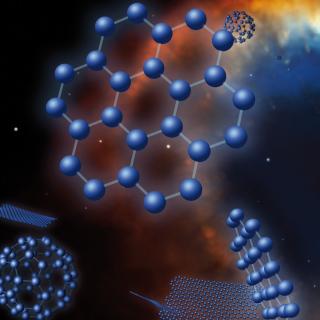Bibcode
Marini, E.; Dell'Agli, F.; Groenewegen, M. A. T.; García-Hernández, D. A.; Mattsson, L.; Kamath, D.; Ventura, P.; D'Antona, F.; Tailo, M.
Referencia bibliográfica
Astronomy and Astrophysics
Fecha de publicación:
3
2021
Revista
Número de citas
15
Número de citas referidas
15
Descripción
Context. Carbon stars have been, and still are, extensively studied. Given their complex internal structure and their peculiar chemical composition, they are living laboratories in which we can test stellar structure and evolution theories of evolved stars. Furthermore, they are the most relevant dust manufacturers, thus playing a crucial role in the evolution of galaxies.
Aims: We aim to study the dust mineralogy of the circumstellar envelope of carbon stars in the Large Magellanic Cloud (LMC) to achieve a better understanding of the dust formation process in the outflow of these objects. We intend to investigate the expected distribution of carbon stars in the observational planes built with the filters of the Mid-Infrared Instrument (MIRI) mounted onboard the James Webb Space Telescope (JWST) to select the best planes allowing an exhaustive characterisation of the stars.
Methods: We compared the synthetic spectral energy distributions, obtained by modelling asymptotic giant branch stars and the dust formation process in the wind, with the spectra of carbon stars in the LMC, taken with the Infrared Spectrograph onboard the Spitzer Space Telescope. From the detailed comparison between synthetic modelling and observation we characterise the individual sources and derive the detailed mineralogy of the dust in the circumstellar envelope.
Results: The sample of stars considered here is composed of stars of diverse mass, formation epoch, degree of obscuration, and metallicity. We find that precipitation of MgS on SiC seeds is common to all non-metal-poor carbon stars. Solid carbon is the dominant dust component, with percentages above 80% in all cases; a percentage between 10% and 20% of carbon dust is under the form of graphite, the remaining being amorphous carbon. Regarding the observational planes based on the MIRI filters, the colour-magnitude ([F770W]-[F1800W], [F1800W]) plane allows the best understanding of the degree of obscuration of the stars, while the ([F1800W]-[F2550W], [F1800W]) diagram allows better discrimination among stars of different metallicities.
Aims: We aim to study the dust mineralogy of the circumstellar envelope of carbon stars in the Large Magellanic Cloud (LMC) to achieve a better understanding of the dust formation process in the outflow of these objects. We intend to investigate the expected distribution of carbon stars in the observational planes built with the filters of the Mid-Infrared Instrument (MIRI) mounted onboard the James Webb Space Telescope (JWST) to select the best planes allowing an exhaustive characterisation of the stars.
Methods: We compared the synthetic spectral energy distributions, obtained by modelling asymptotic giant branch stars and the dust formation process in the wind, with the spectra of carbon stars in the LMC, taken with the Infrared Spectrograph onboard the Spitzer Space Telescope. From the detailed comparison between synthetic modelling and observation we characterise the individual sources and derive the detailed mineralogy of the dust in the circumstellar envelope.
Results: The sample of stars considered here is composed of stars of diverse mass, formation epoch, degree of obscuration, and metallicity. We find that precipitation of MgS on SiC seeds is common to all non-metal-poor carbon stars. Solid carbon is the dominant dust component, with percentages above 80% in all cases; a percentage between 10% and 20% of carbon dust is under the form of graphite, the remaining being amorphous carbon. Regarding the observational planes based on the MIRI filters, the colour-magnitude ([F770W]-[F1800W], [F1800W]) plane allows the best understanding of the degree of obscuration of the stars, while the ([F1800W]-[F2550W], [F1800W]) diagram allows better discrimination among stars of different metallicities.
Proyectos relacionados

Nucleosíntesis y procesos moleculares en los últimos estados de la evolución estelar
Las estrellas de masa baja e intermedia (M < 8 masas solares, Ms) representan la mayoría de estrellas en el Cosmos y terminan sus vidas en la Rama Asintótica de las Gigantes (AGB) - justo antes de formar Nebulosas Planetarias (NPs) - cuando experimentan procesos nucleosintéticos y moleculares complejos. Las estrellas AGB son importantes
Domingo Aníbal
García Hernández